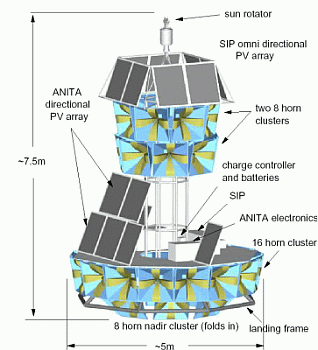Purpose of the flight and payload description
The instrument is a radio telescope to detect ultra-high energy cosmic-ray neutrinos from a scientific balloon flying over the continent of Antarctica. It will be the first NASA observatory for neutrinos of any kind.
Neutrinos are of great interest to astrophysicist as they are the only particle that can reach earth unattenuated at all energies. This is particularly of interest at high energies where other particles and photons will interact with the photons of the microwave background making them unable to propagate and survive over long astrophysical distances. In other words, if the scientists want to see the ultra-high energy universe, they should view it through the "light" of neutrinos.
The ANITA instrument detects these ultra-high energy neutrinos by use of the Askaryan effect. This effect predicts the production of a coherent radio emission from the cascade of particles produced in a high-energy particle interaction. In other words detecting a 'snap' in the radio frequencies caused by the interaction of the ultra-high energy neutrino.
In order to detect this radio emission (Askaryan pulses) it's needed a radio transparent medium for the interaction to occur in - and lots of it since these interactions are rare. Some materials that are radio transparent are salt, sand and ice. Also needs a fairly radio quiet area as the Askaryan pulses are very faint signals.
The ANITA instrument was designed to fly over the continent of Antarctica - the location of some of the most pure ice in the world as well as one of the most radio quiet spots on earth. Flying at 120,000 ft (~ 37 km) the instrument can observe ~1.5 million square kilometers of ice. However Neutrinos are so rare that with a detection area that large the scientists don't expect to see more than a hundred or so events.
Details of the balloon flight

Balloon launched on: 12/21/2008 at 10:17 local
Launch site: Williams Field, McMurdo Station, Antarctica
Balloon launched by: Columbia Scientific Balloon Facility (CSBF)
Balloon manufacturer/size/composition: Zero Pressure Balloon Raven W 39.570.000 cuft - (0.8 mil)
Flight identification number: 590N
End of flight (L for landing time, W for last contact, otherwise termination time): 1/20/2009 at 13:15
Balloon flight duration (F: time at float only, otherwise total flight time in d:days / h:hours or m:minutes - ): 30 d 16 h
Landing site: 122 NM southwest of Siple Dome, Antarctica
The balloon was launched by dynamic method at 10:17 am local time on December 21th and after 8 hours of initial climb it reached float altitude near 120.000 feet to succesfully ride over the polar vortex to start his first Antarctic turn. On January 20th, 2009, was initiated the termination process for the mission, sending the signal that separated the payload from the balloon, via the TDRSS satellite relay system directly from CSBF's Operations Control Center in Palestine, Texas. After a nominal descent under parachute, the instrument landed 122 nautic miles SW of the Siple Dome at 13:15 UTC that same day. It tipped over upon impact, but was in good condition as it continued to transmit data through the Iridium system. Total flight time was 30 days, 15 hours, and 58 minutes.
On January 27, a team from the ANITA mission was deployed to the Siple Dome Camp following plans made during the previous days to use that location as headquarters for the recovery operation. The next day the team was able to spend half the day working on dissasembling the payload and returned to Siple Dome with the data vaults, data computers, twenty antennas, CSBF's Support Instrument Package, and miscellaneous structural components. By Febraury 2 the recovered materials from ANITA where all stored at Siple Dome and two days after they were transported to McMurdo Station for final packing and return to United States.
External references
- ANITA website University of Hawaii (Mauna Loa)
- A search for IceCube events in the direction of ANITA neutrino candidates arXiv - High Energy Astrophysical Phenomena (astro-ph.HE)
- A Search for Ultra-High Energy Neutrinos and Cosmic-Rays with ANITA-2 Doctoral Thesis by Matthew Joseph Mottram
- ANITA balloon launch pictures The Adventures of Stratodude (Mike Smith's BLOG)
- Antarctic radio frequency albedo and implications for cosmic ray reconstruction Radio Sci., 50, 1-17
- Characteristics of Four Upward-pointing Cosmic-ray-like Events Observed with ANITA Phys. Rev. Lett. 117, 071101
- Characterization of Atmosphere-Skimming Cosmic-Ray Showers in High-Altitude Experiments Journal of Cosmology and Astroparticle Physics, Volume 2024, Issue 07, id.065
- Impressive images of ANITA at float The Adventures of Stratodude (Mike Smith's BLOG)
- Neutrinos via the Askaryan effect from long durations balloons (ANITA) Jiwoo Nam presentation at Astrophysics from Antarctica - an IAU symposium
- Observation of Ultra-high-energy Cosmic Rays with the ANITA Balloon-borne Radio Interferometer Instrumentation and Methods for Astrophysics
- Observational Constraints on the Ultra-high Energy Cosmic Neutrino Flux from the Second Flight of the ANITA Experiment submitted to Phys. Rev. Lett.
- Ultra-Relativistic Magnetic Monopole Search with the ANITA-II Balloon-borne Radio Interferometer High Energy Astrophysical Phenomena (astro-ph.HE)
3311If you consider this website interesting or useful, you can help me to keep it up and running with a small donation to cover the operational costs. Just the equivalent of the price of a cup of coffee helps a lot.







